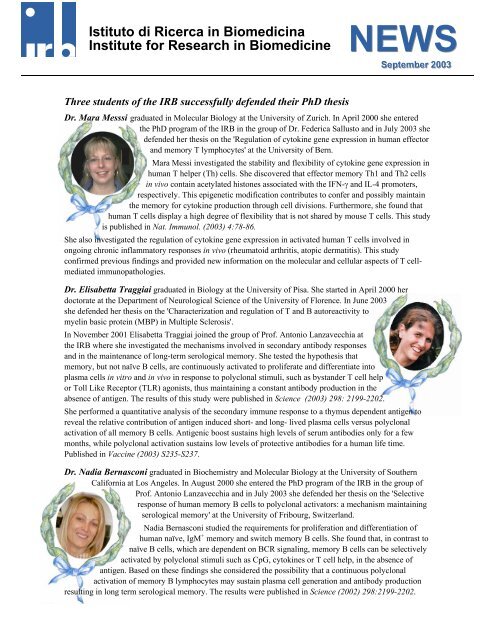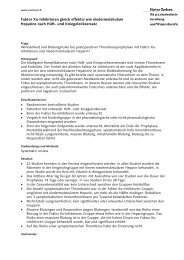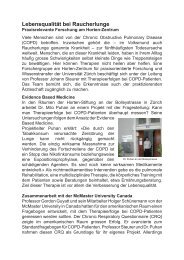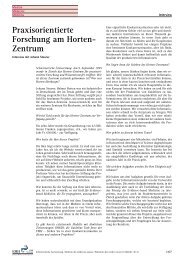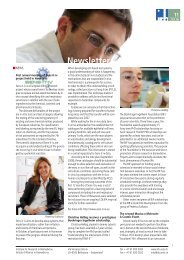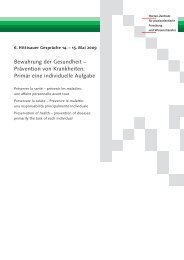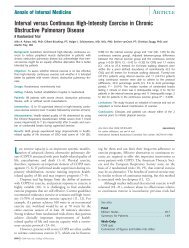Istituto di Ricerca in Biomedicina Institute for Research in ...
Istituto di Ricerca in Biomedicina Institute for Research in ...
Istituto di Ricerca in Biomedicina Institute for Research in ...
You also want an ePaper? Increase the reach of your titles
YUMPU automatically turns print PDFs into web optimized ePapers that Google loves.
<strong>Istituto</strong> <strong>di</strong> <strong>Ricerca</strong> <strong>in</strong> Biome<strong>di</strong>c<strong>in</strong>a<br />
<strong>Institute</strong> <strong>for</strong> <strong>Research</strong> <strong>in</strong> Biome<strong>di</strong>c<strong>in</strong>e<br />
NEWS<br />
Seeppt teembbeerr 22000033<br />
Three students of the IRB successfully defended their PhD thesis<br />
Dr. Mara Messsi graduated <strong>in</strong> Molecular Biology at the University of Zurich. In April 2000 she entered<br />
the PhD program of the IRB <strong>in</strong> the group of Dr. Federica Sallusto and <strong>in</strong> July 2003 she<br />
defended her thesis on the 'Regulation of cytok<strong>in</strong>e gene expression <strong>in</strong> human effector<br />
and memory T lymphocytes' at the University of Bern.<br />
Mara Messi <strong>in</strong>vestigated the stability and flexibility of cytok<strong>in</strong>e gene expression <strong>in</strong><br />
human T helper (Th) cells. She <strong>di</strong>scovered that effector memory Th1 and Th2 cells<br />
<strong>in</strong> vivo conta<strong>in</strong> acetylated histones associated with the IFN-γ and IL-4 promoters,<br />
respectively. This epigenetic mo<strong>di</strong>fication contributes to confer and possibly ma<strong>in</strong>ta<strong>in</strong><br />
the memory <strong>for</strong> cytok<strong>in</strong>e production through cell <strong>di</strong>visions. Furthermore, she found that<br />
human T cells <strong>di</strong>splay a high degree of flexibility that is not shared by mouse T cells. This study<br />
is published <strong>in</strong> Nat. Immunol. (2003) 4:78-86.<br />
She also <strong>in</strong>vestigated the regulation of cytok<strong>in</strong>e gene expression <strong>in</strong> activated human T cells <strong>in</strong>volved <strong>in</strong><br />
ongo<strong>in</strong>g chronic <strong>in</strong>flammatory responses <strong>in</strong> vivo (rheumatoid arthritis, atopic dermatitis). This study<br />
confirmed previous f<strong>in</strong><strong>di</strong>ngs and provided new <strong>in</strong><strong>for</strong>mation on the molecular and cellular aspects of T cellme<strong>di</strong>ated<br />
immunopathologies.<br />
Dr. Elisabetta Traggiai graduated <strong>in</strong> Biology at the University of Pisa. She started <strong>in</strong> April 2000 her<br />
doctorate at the Department of Neurological Science of the University of Florence. In June 2003<br />
she defended her thesis on the 'Characterization and regulation of T and B autoreactivity to<br />
myel<strong>in</strong> basic prote<strong>in</strong> (MBP) <strong>in</strong> Multiple Sclerosis'.<br />
In November 2001 Elisabetta Traggiai jo<strong>in</strong>ed the group of Prof. Antonio Lanzavecchia at<br />
the IRB where she <strong>in</strong>vestigated the mechanisms <strong>in</strong>volved <strong>in</strong> secondary antibody responses<br />
and <strong>in</strong> the ma<strong>in</strong>tenance of long-term serological memory. She tested the hypothesis that<br />
memory, but not naïve B cells, are cont<strong>in</strong>uously activated to proliferate and <strong>di</strong>fferentiate <strong>in</strong>to<br />
plasma cells <strong>in</strong> vitro and <strong>in</strong> vivo <strong>in</strong> response to polyclonal stimuli, such as bystander T cell help<br />
or Toll Like Receptor (TLR) agonists, thus ma<strong>in</strong>ta<strong>in</strong><strong>in</strong>g a constant antibody production <strong>in</strong> the<br />
absence of antigen. The results of this study were published <strong>in</strong> Science (2003) 298: 2199-2202.<br />
She per<strong>for</strong>med a quantitative analysis of the secondary immune response to a thymus dependent antigen to<br />
reveal the relative contribution of antigen <strong>in</strong>duced short- and long- lived plasma cells versus polyclonal<br />
activation of all memory B cells. Antigenic boost susta<strong>in</strong>s high levels of serum antibo<strong>di</strong>es only <strong>for</strong> a few<br />
months, while polyclonal activation susta<strong>in</strong>s low levels of protective antibo<strong>di</strong>es <strong>for</strong> a human life time.<br />
Published <strong>in</strong> Vacc<strong>in</strong>e (2003) S235-S237.<br />
Dr. Na<strong>di</strong>a Bernasconi graduated <strong>in</strong> Biochemistry and Molecular Biology at the University of Southern<br />
Cali<strong>for</strong>nia at Los Angeles. In August 2000 she entered the PhD program of the IRB <strong>in</strong> the group of<br />
Prof. Antonio Lanzavecchia and <strong>in</strong> July 2003 she defended her thesis on the 'Selective<br />
response of human memory B cells to polyclonal activators: a mechanism ma<strong>in</strong>ta<strong>in</strong><strong>in</strong>g<br />
serological memory' at the University of Fribourg, Switzerland.<br />
Na<strong>di</strong>a Bernasconi stu<strong>di</strong>ed the requirements <strong>for</strong> proliferation and <strong>di</strong>fferentiation of<br />
human naïve, IgM + memory and switch memory B cells. She found that, <strong>in</strong> contrast to<br />
naïve B cells, which are dependent on BCR signal<strong>in</strong>g, memory B cells can be selectively<br />
activated by polyclonal stimuli such as CpG, cytok<strong>in</strong>es or T cell help, <strong>in</strong> the absence of<br />
antigen. Based on these f<strong>in</strong><strong>di</strong>ngs she considered the possibility that a cont<strong>in</strong>uous polyclonal<br />
activation of memory B lymphocytes may susta<strong>in</strong> plasma cell generation and antibody production<br />
result<strong>in</strong>g <strong>in</strong> long term serological memory. The results were published <strong>in</strong> Science (2002) 298:2199-2202.
<strong>Istituto</strong> <strong>di</strong> <strong>Ricerca</strong> <strong>in</strong> Biome<strong>di</strong>c<strong>in</strong>a<br />
<strong>Institute</strong> <strong>for</strong> <strong>Research</strong> <strong>in</strong> Biome<strong>di</strong>c<strong>in</strong>e<br />
NEWS<br />
Seeppt teembbeerr 22000033<br />
In another chapter of her thesis she <strong>in</strong>vestigated the role of Toll like receptors (TLRs) <strong>in</strong> human B cell<br />
activation. She found that <strong>in</strong> human naïve B cells, most TLRs are expressed at low to undetectable levels, but<br />
the expression of TLR9 and TLR10 is rapidly <strong>in</strong>duced follow<strong>in</strong>g B-cell-receptor (BCR) trigger<strong>in</strong>g. In<br />
contrast, memory B cells express several TLRs at constitutively high levels. The requirement of BCR to<br />
<strong>in</strong>duce expression of TLRs <strong>in</strong> human naïve B cells prevents polyclonal activation <strong>in</strong> a primary response and<br />
restricts the stimulation to antigen-specific B cells. The constitutive expression of TLRs <strong>in</strong> memory B cells<br />
allows a polyclonal activation of the entire memory pool. Thus, <strong>in</strong> human B cells TLRs are downstream of<br />
BCR and play a role both <strong>in</strong> the primary response and <strong>in</strong> the memory phase. Published <strong>in</strong> Blood<br />
2003:101:4500-4504.<br />
Two PhD students of the IRB receive the ASIRB-ROCHE research award 2002<br />
On March 14 th , 2003 Na<strong>di</strong>a Bernasconi and Elisabetta Traggiai received the 2002 research award from<br />
ASIRB (Associazione della Svizzera italiana per la <strong>Ricerca</strong> Biome<strong>di</strong>ca) and Roche-Diagnostics <strong>for</strong> their<br />
work on 'Polyconal activation of human memory B cells and ma<strong>in</strong>tenance of serological memory'. The<br />
award <strong>di</strong>st<strong>in</strong>guishes excellence <strong>in</strong> biome<strong>di</strong>cal research of young scientist <strong>in</strong> Switzerland to promote scientific<br />
activities <strong>in</strong> Tic<strong>in</strong>o. The stu<strong>di</strong>es per<strong>for</strong>med by Na<strong>di</strong>a Bernasconi and Elisabetta Traggiai were part of their<br />
PhD-theses developed at the IRB.


